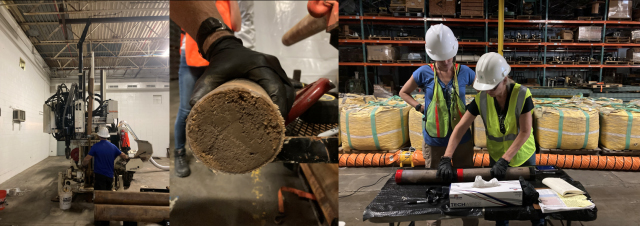Addressing Challenges Of PFAS: Protecting Groundwater And Treating Contaminated Sources
By U.S. EPA
Groundwater is a vital resource across the United States and throughout the world. Over 50 percent of people in the United States depend on groundwater for safe drinking water. Groundwater is also one of our most important sources of water for irrigation and food production.
Unfortunately, groundwater is susceptible to pollutants including per- and polyfluoroalkyl substances, or PFAS. PFAS are a large group of human-made environmentally persistent organic compounds with properties that make many of them toxic and persistent in the environment. Since the 1940s, PFAS have been manufactured and used in a variety of industries around the globe, including in the United States. These chemicals are used in items such as adhesives, fire-fighting foams, cosmetics, paper products, and stain and water repellants.

EPA scientists on Wilkin’s team collect soil samples to understanding PFAS transport in the unsaturated zone. They use a roto-sonic drill rig to collect cores from the saturated and unsaturated zones. The cores are logged in the field and transported back to the lab for mineralogical and chemical analysis.
PFAS enter the environment at sites where they are made, used, disposed of, or spilled. For example, PFAS are mobile and can be transported through rainwater run-off and enter surface water — for example lakes and ponds — or seep through the soil and migrate into large groundwater aquifers that can be important underground sources of drinking water.
In 2019, EPA geochemist Rick Wilkin, helped to develop three teams to focus on treatment, characterization, and risk management of PFAS in groundwater. This collaborative work includes EPA experts from Regions 2 and 3, the New Jersey Department of Environmental Protection (NJDEP), the New York State Department of Environmental Conservation (NYSDEC), and the New Jersey Institute of Technology (NJIT). The focus of the first team led by Wilkin is understanding PFAS partitioning between soil and groundwater by examining the traditional methods for predicting how these compounds enter groundwater. This process typically involves downward movement of PFAS through soils of the unsaturated zone (the area above groundwater) in areas where they have been used with continuing migration of PFAS into the underlying groundwater.
A second group led by EPA researcher Michael Brooks is comprised of EPA scientists and post-doctoral researchers. The team is looking at how PFAS compounds behave in soil environments known as the “source zone”. An example of a typical PFAS contamination scenario is the aboveground application of firefighting foam. Following a contamination incident or release, these compounds can move through the unsaturated zone into groundwater. When firefighting compounds are sprayed, high concentrations are present at the surface and concentrations decrease as they percolate into the ground. Brooks and his team are studying key chemical characteristics of these compounds that tend to tie them up in the unsaturated zone, causing them to persist in soil and slowly bleed into groundwater which can be a long-lasting problem. Studies to date indicate that PFAS chemicals do not “flush out” of soil like other contaminants. Instead, these compounds stick and release slowly out of source zones.
EPA soil scientist Chunming Su is leading the third group, also consisting of EPA scientists, post-doctoral researchers, and collaborators from NJIT. This team is looking at cleanup options using biochars — carbon feedstocks including dairy manure and chicken litter — that when combusted, transform into a carbon or charcoal-like material containing some ideal characteristic properties for contaminant adsorption. These biochar materials are potential reactants that can be used for PFAS cleanup/treatment. Because of the strong chemical bonds in PFAS chemicals, they are difficult to destroy. This means that aggressive approaches like high temperature incineration or focused chemical reactions are needed for PFAS destruction. But the use of biochar as an adsorptive medium is a treatment option to remove PFAS from groundwater and to potentially stop the migration of PFAS chemicals in the subsurface.
Progress on these research initiatives has been made on several fronts. An examination of all available literature on PFAS soil-to-groundwater chemical partitioning has revealed that the standard approaches used by EPA’s regions and state partners are unable to accurately predict potential impacts to groundwater from PFAS-contaminated soil. This means that site-specific measurement tools to aid site practitioners in evaluating groundwater vulnerability at PFAS-contaminated sites are needed. Development of these tools is underway. In addition, laboratory studies have been implemented to measure characteristic chemical parameters that can be used to understand PFAS binding in source zones. The lab measurements are for a parameter known as surface tension. Understanding surface tension can help predict PFAS transport and retention through source zones.
EPA is committed to supporting states, tribes and local communities in addressing challenges with PFAS. EPA’s work on these pressing concerns is ongoing as are the research efforts of the teams led by Wilkin, Brooks, and Su. Because of the Covid pandemic, important field and laboratory investigations have been slowed down.
“The answers can’t come soon enough,“ said Wilkin. “But the EPA science is being done carefully and will lead to the problem-based solutions for our nation’s communities.”
